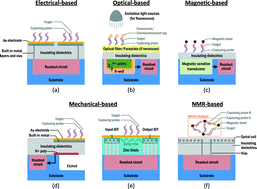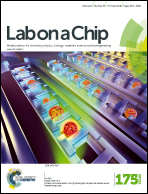CMOS biosensors for in vitro diagnosis – transducing mechanisms and applications
Abstract
Complementary metal oxide semiconductor (CMOS) technology enables low-cost and large-scale integration of transistors and physical sensing materials on tiny chips (e.g., <1 cm2), seamlessly combining the two key functions of biosensors: transducing and signal processing. Recent CMOS biosensors unified different transducing mechanisms (impedance, fluorescence, and nuclear spin) and readout electronics have demonstrated competitive sensitivity for in vitro diagnosis, such as detection of DNA (down to 10 aM), protein (down to 10 fM), or bacteria/cells (single cell). Herein, we detail the recent advances in CMOS biosensors, centering on their key principles, requisites, and applications. Together, these may contribute to the advancement of our healthcare system, which should be decentralized by broadly utilizing point-of-care diagnostic tools.

- This article is part of the themed collection: Lab on a Chip Recent Review Articles

 Please wait while we load your content...
Please wait while we load your content...